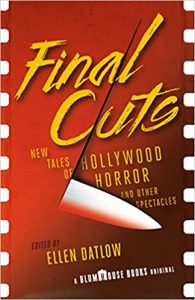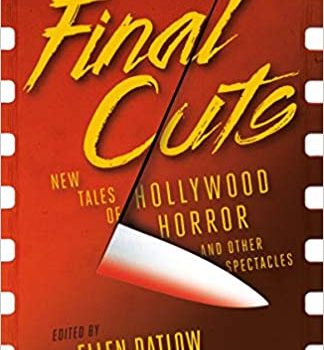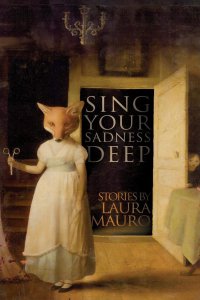Paula Guran Reviews Final Cuts, Edited by Ellen Datlow
 Final Cuts: New Tales of Hollywood Horror and Other Spectacles, Ellen Datlow, ed. (Blumhouse Books/Anchor Books 978-0-525565-75-8, $16.95, 480pp, tp) June 2020.
Final Cuts: New Tales of Hollywood Horror and Other Spectacles, Ellen Datlow, ed. (Blumhouse Books/Anchor Books 978-0-525565-75-8, $16.95, 480pp, tp) June 2020.
Ellen Datlow anthologized cinema-related horror in 2014 tapping reprints in The Cutting Room: Dark Reflections of the Silver Screen. This time she compiles original stories written for Final Cuts. Up-to-date stories allow for the use of new media, and a few of the authors do just that. It’s another good volume, and the 18 stories are all worth reading, but some are not as stellar as others. I suspect, however, that individual taste will decide which tales please each reader the most. My tastes may dramatically differ from yours.
A.C. Wise’s “Exhalation #10” is a splendid story about two men (one a former film student turned cop, the other still making movies), films of a brutal killer’s victims, friendship, and the sharing of an impossible burden of pain.
In “Das Gesicht” by Dale Bailey, a writer interviews an elderly cinematographer about the “lost’ film he shot for a renowned director whose vision of the world was so affected by his experiences in WWI that he viewed it as nothing but butchery, filth, and corruption. Bailey masterfully builds suspense about the film and reveals its horror.
“Insanity Among Penguins” by Brian Hodge deftly explores the characters of Lydia, who still owns a video store, and Troy, a film buff who lusts after a lost Werner Herzog documentary. After traveling from Chicago to Vancouver, they view the film – which Hodge details – and everything changes forever.
Kelley Armstrong’s “Drunk Physics” is au courant: brilliant Hannah and beautiful Trinity, postgrad physics students, start streaming Drunk Girl Physics (which is just what the title implies) on YouTube. It quickly becomes a lucrative sponsored web series. Friction builds between the two friends when a “ghost orb” appears and haunts the series.
One might fear that the short “Snuff in Six Scenes” by Richard Kadrey will be too gruesome, but it is nicely twisty rather than grisly. A suicidal young woman agrees to be murdered by a man who films her lengthy torture, but Jenny is not exactly a helpless victim.
Willa is barely managing to keep a roof over her and her kids’ heads in “From the Balcony of the Idawolf Arms” by Jeffrey Ford. The roof belongs to a weird old apartment building, the Idawolf Arms. Willa doesn’t realize just how weird the place is, but her children, Olen and Dottie, do. An unsettling tale.
Stephen Graham Jones gets creepy in “Lords of the Matinee”. The narrator takes his 72-year-old, hearing-impaired father-in-law to the movies while his wife cleans the old man’s apartment. After the geezer dozes off, the narrator tries his assisted hearing device. It delivers something more than dialogue.
In “The One We Tell Bad Children” by Laird Barron, the eldest of an isolated family of many children protects his siblings from evil, but exposes them to a damnably banned film. Barron employs his unique nihilistic horror humor to great effect here. If you like his work, you’ll love the story. If you don’t, it may be unfathomable.
John Langan’s “Altered Beast, Altered Me” is told in e-epistolary form between two horror writers. One buys a prop “Dracula’s ring” and begins writing fiction (which he emails to the other writer) with autobiographical detail about a man who owns the ring and is suffering from an unknown illness/vampirism. There’s a great deal of interest here, including critiques with plenty of literary references, but the stories are sketchy and it is all too lengthy for the back-and-forth format.
“Family” by Lisa Morton involves a terrifying ghost that can be seen, by some, in a film that was not intended to be horrific. It’s chock full of fascinating detail (augmented with fiction) about Hong Kong cinema, but the core story isn’t as substantial. In “Night of the Living” by Paul Cornell, a multiplex manager shows Weyward House, a cult folk horror movie from the 1970s, as a Monday matinee for seniors, with deadly results. The story sustains interest, but how a restored, extended, re-released limited-run film was seen by reviewers and others without consequence nagged. A legendary producer, in Christopher Golden’s “The Face Is a Mask”, owns a mask from a cult film. A young man whose mother made a real-life horrific appearance in the film wants to buy it. This is very well executed, with a bwah-ha-ha ending, but it is a rehash of very traditional tropes.
“Cut Frame” by Gemma Files tells – through fictional transcripts and data – of a Canadian dentist who invests in a film and gains access to its B-list star, the alluring aging-yet-ageless Tamar Dusk, with whom he has been fascinated most of his life. A story with all the right elements to be effective, it somehow falls short. In “Hungry Girls” by Cassandra Khaw, producer/director/creep Roger discovers a girl singing to the dead during the Hungry Ghost Festival in Kuala Lumpur and tries to take advantage of her. He shouldn’t have.
A monstrous child rapist and murderer of one hundred victims is sentenced to a public execution that will be filmed in “Folie à Deux, or the Ticking Hourglass” by Usman T. Malik. Full of exquisite setting detail, the story has a terrific ending, but is somewhat confusing.
Studio fixer Jordan Harper has to fix the unfixable, but he still manages in the action-packed but slight “Many Mouths to Make a Meal” by Garth Nix.
After stealing a camcorder, Ben Evans starts making movies with the corpses of his mother and father as the actors. Guess what happens when he shows his masterpiece (in his death-stench home) to others. “A Ben Evans Film” by Josh Malerman is the least accomplished story in the book.
Read all the stories. You are sure to disagree with me on some!
Paula Guran has edited more than 40 science fiction, fantasy, and horror anthologies and more than 50 novels and collections featuring the same. She’s reviewed and written articles for dozens of publications. She lives in Akron, Ohio, near enough to her grandchildren to frequently be indulgent.
This review and more like it in the September 2020 issue of Locus.
 While you are here, please take a moment to support Locus with a one-time or recurring donation. We rely on reader donations to keep the magazine and site going, and would like to keep the site paywall free, but WE NEED YOUR FINANCIAL SUPPORT to continue quality coverage of the science fiction and fantasy field.
While you are here, please take a moment to support Locus with a one-time or recurring donation. We rely on reader donations to keep the magazine and site going, and would like to keep the site paywall free, but WE NEED YOUR FINANCIAL SUPPORT to continue quality coverage of the science fiction and fantasy field.
©Locus Magazine. Copyrighted material may not be republished without permission of LSFF.






